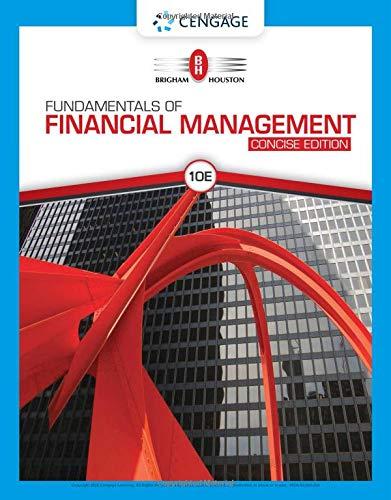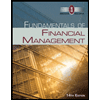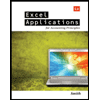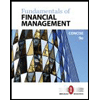
Fundamentals of Financial Management, Concise Edition
10th Edition
ISBN: 9781337911054
Author: Eugene F. Brigham, Joel F. Houston
Publisher: Cengage Learning US
expand_more
expand_more
format_list_bulleted
Question
Chapter 14, Problem 2TCL
Summary Introduction
To Explain: Whether cash flow per share exceeds the dividends per share by a safe margin for A Company
Dividend:
The dividend is the share of company’s earnings, which is decided by the board of directors to distribute among its shareholders. It is done when a company earns a profit in excess, which is expected and from that profit, they reinvest a certain amount in business and pay other portion as the dividend.
Expert Solution & Answer
Trending nowThis is a popular solution!

Students have asked these similar questions
What is the 50/30/20 budgeting rule in finance?
i need answwr
What is the 50/30/20 budgeting rule in finance?
need help
What is a derivative, and name two types commonly used in hedging?no ai
Chapter 14 Solutions
Fundamentals of Financial Management, Concise Edition
Ch. 14 - Prob. 1QCh. 14 - Prob. 2QCh. 14 - Would it ever be rational for a firm to borrow...Ch. 14 - Modigliani and Miller (MM), on the one hand, and...Ch. 14 - Prob. 5QCh. 14 - One position expressed in the financial literature...Ch. 14 - Prob. 7QCh. 14 - What is the difference between a stock dividend...Ch. 14 - Most firms like to have their stock selling at a...Ch. 14 - Prob. 10Q
Ch. 14 - Prob. 11QCh. 14 - RESIDUAL DIVIDEND MODEL Altamonte...Ch. 14 - Prob. 2PCh. 14 - STOCK REPURCHASES Gamma Industries has net income...Ch. 14 - Prob. 4PCh. 14 - EXTERNAL EQUITY FINANCING Coastal Carolina Heating...Ch. 14 - RESIDUAL DIVIDEND MODEL Walsh Company is...Ch. 14 - DIVIDENDS Brooks Sporting Inc. is prepared to...Ch. 14 - Prob. 8PCh. 14 - ALTERNATIVE DIVIDEND POLICIES In 2018, Keenan...Ch. 14 - Prob. 10SPCh. 14 - Prob. 11ICCh. 14 - Prob. 1TCLCh. 14 - Prob. 2TCLCh. 14 - Prob. 3TCLCh. 14 - Investors are more concerned with future dividends...Ch. 14 - Prob. 5TCL
Knowledge Booster
Similar questions
arrow_back_ios
SEE MORE QUESTIONS
arrow_forward_ios
Recommended textbooks for you
 Fundamentals Of Financial Management, Concise Edi...FinanceISBN:9781337902571Author:Eugene F. Brigham, Joel F. HoustonPublisher:Cengage Learning
Fundamentals Of Financial Management, Concise Edi...FinanceISBN:9781337902571Author:Eugene F. Brigham, Joel F. HoustonPublisher:Cengage Learning Fundamentals of Financial Management (MindTap Cou...FinanceISBN:9781285867977Author:Eugene F. Brigham, Joel F. HoustonPublisher:Cengage Learning
Fundamentals of Financial Management (MindTap Cou...FinanceISBN:9781285867977Author:Eugene F. Brigham, Joel F. HoustonPublisher:Cengage Learning Fundamentals of Financial Management (MindTap Cou...FinanceISBN:9781337395250Author:Eugene F. Brigham, Joel F. HoustonPublisher:Cengage Learning
Fundamentals of Financial Management (MindTap Cou...FinanceISBN:9781337395250Author:Eugene F. Brigham, Joel F. HoustonPublisher:Cengage Learning- Principles of Accounting Volume 1AccountingISBN:9781947172685Author:OpenStaxPublisher:OpenStax College
 Excel Applications for Accounting PrinciplesAccountingISBN:9781111581565Author:Gaylord N. SmithPublisher:Cengage Learning
Excel Applications for Accounting PrinciplesAccountingISBN:9781111581565Author:Gaylord N. SmithPublisher:Cengage Learning Fundamentals of Financial Management, Concise Edi...FinanceISBN:9781305635937Author:Eugene F. Brigham, Joel F. HoustonPublisher:Cengage Learning
Fundamentals of Financial Management, Concise Edi...FinanceISBN:9781305635937Author:Eugene F. Brigham, Joel F. HoustonPublisher:Cengage Learning

Fundamentals Of Financial Management, Concise Edi...
Finance
ISBN:9781337902571
Author:Eugene F. Brigham, Joel F. Houston
Publisher:Cengage Learning

Fundamentals of Financial Management (MindTap Cou...
Finance
ISBN:9781285867977
Author:Eugene F. Brigham, Joel F. Houston
Publisher:Cengage Learning

Fundamentals of Financial Management (MindTap Cou...
Finance
ISBN:9781337395250
Author:Eugene F. Brigham, Joel F. Houston
Publisher:Cengage Learning

Principles of Accounting Volume 1
Accounting
ISBN:9781947172685
Author:OpenStax
Publisher:OpenStax College

Excel Applications for Accounting Principles
Accounting
ISBN:9781111581565
Author:Gaylord N. Smith
Publisher:Cengage Learning

Fundamentals of Financial Management, Concise Edi...
Finance
ISBN:9781305635937
Author:Eugene F. Brigham, Joel F. Houston
Publisher:Cengage Learning